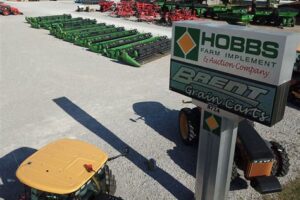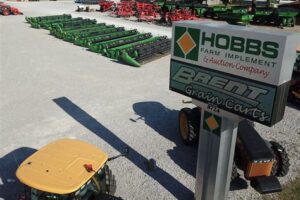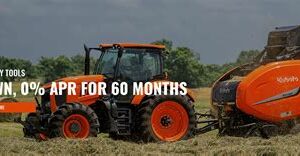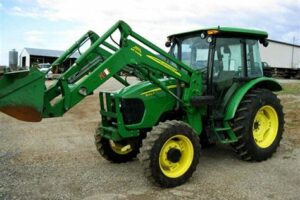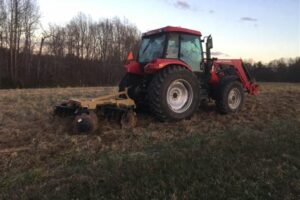Table of Contents
Discover the charm of old farm equipment and delve into the rich history of agricultural machinery. From vintage tractors to antique plows, explore the evolution of farming technology and its impact on society. Unearth the stories behind these timeless relics and gain a newfound appreciation for the ingenuity of our ancestors.
Old farm equipment holds a certain allure, evoking images of a bygone era when the land was tamed by hardworking hands and the machinery at their disposal. These relics of the past possess a charm that is both nostalgic and captivating, as they stand as silent witnesses to the ingenuity and perseverance of those who came before us. With their weathered surfaces, creaking joints, and rusted gears, these ancient tools tell stories of a time when agriculture relied on sturdy craftsmanship rather than modern technology. As we delve into the world of old farm equipment, prepare to be transported back in time, where the beauty of simplicity intertwines with the efficiency of innovation.
The Importance of Old Farm Equipment
Old farm equipment holds a special place in the history of agriculture. These tools and machines were once the backbone of farming operations, helping to cultivate the land, plant seeds, harvest crops, and perform various other essential tasks. While modern technology has largely replaced these old implements, they still serve as a reminder of the past and the hard work that went into feeding the world. In this article, we will explore the significance of old farm equipment and the fascinating stories they tell.
The Evolution of Farming
Old farm equipment provides a glimpse into the evolution of farming practices over the years. From simple hand tools to horse-drawn plows and eventually to steam-powered machinery, each era brought new advancements that revolutionized agriculture. These relics of the past allow us to appreciate the ingenuity and hard work of those who came before us, paving the way for modern farming techniques.
The Rustic Charm of Antique Tools
Antique farm tools exude a sense of rustic charm and nostalgia. Their weathered appearances and worn-out parts tell tales of countless hours spent in the fields, battling the elements to produce food for families and communities. These tools often find new life as decorative pieces, adorning gardens or barns, serving as a constant reminder of the hard work and dedication that went into farming in the past.
The Value of Preservation
Preserving old farm equipment is crucial for historical and educational purposes. These artifacts provide valuable insights into the agricultural practices of bygone eras, allowing future generations to learn from the past. Museums and collectors play a vital role in safeguarding these treasures, ensuring that the stories of our agricultural heritage are not forgotten.
The Significance of Horse-Drawn Plows
Horse-drawn plows were an essential tool in early agriculture, revolutionizing the way fields were cultivated. These plows, typically made of wood with an iron or steel blade, were pulled by horses or oxen, breaking up the soil and preparing it for planting. They represent a significant advancement in farming technology, allowing farmers to cover larger areas more efficiently.
The Legacy of the Threshing Machine
The invention of the threshing machine dramatically transformed the harvesting process. Before its advent, grains such as wheat had to be threshed by hand, a labor-intensive task. The threshing machine automated this process, separating the grain from the straw, saving farmers countless hours of manual labor. These machines played a crucial role in increasing productivity and easing the burden on farm workers.
The Evolution of Tractors
Tractors have come a long way since their early days as steam-powered behemoths. The evolution of tractors is a testament to human innovation and the desire for more efficient agricultural practices. From steam engines to gasoline-powered machines and eventually to today’s high-tech, computer-controlled tractors, these vehicles have revolutionized farming, making it faster, easier, and more productive.
The Role of Harvesters
Harvesters are a critical piece of equipment in modern agriculture, automating the process of cutting and gathering crops. These machines have largely replaced manual labor, allowing farmers to harvest vast fields in a fraction of the time. Old harvesters remind us of the ingenuity and advances made in agricultural technology, enabling us to feed a growing population more efficiently.
The Enduring Legacy of Cultivators
Cultivators have been used for centuries to prepare the soil for planting and control weeds. These machines, often pulled by horses or tractors, helped break up compacted soil and remove competing plants, ensuring optimal growing conditions for crops. The enduring legacy of cultivators lies in their ability to improve soil health, leading to higher yields and sustainable farming practices.
A Tribute to the Past
Old farm equipment serves as a tribute to the pioneers of agriculture, reminding us of their resilience, hard work, and dedication. These tools and machines played a crucial role in shaping the world we live in today, enabling us to enjoy an abundance of food. As we admire these relics from the past, let us not forget the sacrifices made by those who toiled the land and laid the foundation for modern farming.
Introduction to Old Farm Equipment
Old farm equipment refers to machinery and tools that were commonly used in agriculture several decades ago. These pieces of equipment, although outdated and no longer in use, played a significant role in shaping the history of farming. Today, they are often collected as antiques or displayed in museums to commemorate the agricultural practices of earlier times.
Importance of Preserving Old Farm Equipment
Preserving old farm equipment is crucial for maintaining a connection to our agricultural heritage. These artifacts serve as a tangible reminder of the hard work and ingenuity of farmers who relied on them. By preserving and documenting the history of these tools, we can gain insights into how farming techniques and technology have evolved over time.
Types of Old Farm Equipment
There is a wide array of old farm equipment, each with its specific purpose. Some common examples include plows, seeders, harvesters, threshers, and reapers. These machines were designed to streamline various farming tasks, such as preparing the soil, planting seeds, harvesting crops, and processing agricultural produce.
Evolution of Old Farm Equipment
Old farm equipment has gone through several stages of evolution. Initially, manual tools like sickles and wooden plows were prevalent. With the industrial revolution, mechanized equipment began to replace these traditional tools. Steam-powered and later petrol-powered machines drastically increased the efficiency and productivity of farming.
Challenges in Restoring Old Farm Equipment
Restoring old farm equipment can be a complex task. Finding and sourcing original parts for repair can be challenging due to their rarity. Additionally, restoring machinery that may have been neglected or damaged over time requires specialized knowledge and expertise. However, the restoration process can be immensely rewarding, allowing enthusiasts to bring these vintage machines back to their former glory.
Historical Significance of Old Farm Equipment
Old farm equipment holds immense historical significance as it symbolizes the technological advancements made in agriculture. Each piece represents the ingenuity and resourcefulness of farmers who utilized these tools to sustain their livelihoods. Studying the history of farm equipment helps us understand the challenges faced by early farmers and the impact of technology on agricultural practices.
Collecting Old Farm Equipment
Collecting old farm equipment has become a hobby for many enthusiasts. These collectors appreciate the craftsmanship and artistry displayed in these machines. They often seek rare or unique pieces to add to their collections, contributing to the preservation and documentation of agricultural history.
Educational Value of Old Farm Equipment
Old farm equipment serves as an educational tool, allowing current and future generations to learn about the advancements in agriculture. Museums and exhibitions dedicated to old farm equipment provide hands-on experiences that demonstrate how farming has evolved over time. By showcasing these machines, we can educate and inspire others to appreciate the innovations that have shaped our agricultural practices.
As a professional in the agricultural industry, I believe that old farm equipment still holds value and can be a valuable asset on any farm. While new technologies and modern machinery have undoubtedly revolutionized farming practices, there are several reasons why using old farm equipment can still be a viable option for farmers:
- Durability: Old farm equipment was built to last. It was designed with sturdy materials and robust construction, making it highly durable and capable of withstanding harsh conditions. This longevity translates into cost savings for farmers, as they don’t have to frequently replace or repair their machinery.
- Cost-effectiveness: Purchasing new farm equipment can be a significant investment, especially for small-scale farmers or those just starting out. Utilizing old farm equipment allows farmers to save money without compromising functionality. Second-hand machinery can often be acquired at a fraction of the cost of new equipment, freeing up funds for other essential farm expenses.
- Adaptability: Old farm equipment can be versatile and adaptable to various farming practices. While newer models may come with specific features designed for particular tasks, older machinery can be easily modified or retrofitted to meet the unique needs of a farm. This flexibility allows farmers to customize their equipment without breaking the bank.
- Minimal Technological Complexity: Old farm equipment is generally less complex than its modern counterparts. It doesn’t rely heavily on complex computer systems or intricate electronics. This simplicity means that farmers can often handle maintenance and repairs themselves, reducing downtime and the need for costly professional assistance.
- Environmental Considerations: In today’s world, sustainability and reducing environmental impact are crucial considerations. By utilizing old farm equipment, farmers can contribute to sustainable practices by extending the lifespan of machinery and reducing waste. The carbon footprint associated with manufacturing new equipment is also minimized.
In conclusion, while modern farm equipment undoubtedly offers numerous benefits, it is essential not to overlook the value of old farm equipment. Its durability, cost-effectiveness, adaptability, simplicity, and environmental advantages make it a viable option for farmers striving for efficiency and sustainability in their operations. As professionals, we should encourage the use of old farm equipment and support farmers in making informed decisions that align with their unique needs and circumstances.
Thank you for visiting our blog and taking the time to learn more about old farm equipment. We hope that the information provided has been insightful and valuable to you. As we conclude this article, we would like to recap some key points and leave you with a final thought.
Firstly, it is important to recognize the historical significance of old farm equipment. These machines were once the backbone of agriculture and played a crucial role in feeding communities and nations. They represent a bygone era, when hard work and ingenuity were the driving forces behind agricultural success. By understanding and appreciating the importance of these tools, we can gain a deeper appreciation for the progress that has been made in modern farming practices.
Secondly, old farm equipment serves as a reminder of the resourcefulness and craftsmanship of the past. In a time before advanced machinery and technology, farmers had to rely on their own skills and creativity to maintain and repair their equipment. The simplicity of these machines allowed for easier maintenance and customization, fostering a sense of pride and ownership among farmers. Today, as we marvel at the efficiency and precision of modern farming equipment, it is important to remember the roots from which these advancements have grown.
In conclusion, old farm equipment holds a special place in the history of agriculture. It symbolizes the hard work, dedication, and innovation of farmers throughout the years. While technological advancements have revolutionized the industry, it is essential to remember and honor the legacy of these tools. Whether displayed in museums, preserved on farms, or collected by enthusiasts, old farm equipment tells a story of a simpler time and reminds us of the foundations on which modern agriculture is built.
We hope that this article has sparked your interest in the world of old farm equipment and encouraged you to explore this fascinating aspect of agricultural history further. Thank you again for joining us on this journey, and we look forward to sharing more engaging and informative content with you in the future. Happy farming!
Video Old Farm Equipment
1. What is considered old farm equipment?
Old farm equipment refers to machinery and tools that were commonly used in agricultural practices several decades ago. This includes but is not limited to tractors, plows, seeders, harvesters, threshers, hay balers, and various hand tools such as scythes and sickles.
2. Where can I find old farm equipment for sale?
There are numerous places where you can find old farm equipment for sale:
- Online classified websites such as Craigslist, eBay, and Facebook Marketplace often have listings for old farm equipment.
- Auctions and estate sales frequently offer vintage farm machinery.
- Local farming communities or historical societies might organize events where old farm equipment is bought, sold, or traded.
- Antique dealers and specialized vintage farming equipment dealerships often have a selection of old farm equipment available for purchase.
3. How much does old farm equipment cost?
The cost of old farm equipment can vary widely depending on factors such as age, condition, rarity, and demand. While some pieces may be relatively affordable, others can be quite expensive, especially if they are highly sought after by collectors. It’s recommended to research recent sales and consult with experts or dealers to get an idea of the current market value for specific items.
4. Can old farm equipment still be used today?
Yes, old farm equipment can still be used today. Many antique farm implements are built to last and can still perform their intended tasks. However, it’s important to note that older machinery may require more maintenance and repairs compared to modern equipment. Additionally, certain safety standards and regulations may need to be considered before operating older farm machinery.
5. Are there any advantages to using old farm equipment?
Using old farm equipment can have certain advantages:
- Cost savings: Vintage machinery is often more affordable compared to newer models.
- Durability: Older farm equipment was built with sturdy materials, allowing it to withstand heavy use and harsh conditions.
- Sustainability: Reusing and refurbishing old equipment reduces waste and promotes sustainability.
- Historical value: Owning and operating antique farm equipment can be a way to preserve agricultural history and traditions.
6. How can I maintain and restore old farm equipment?
Maintaining and restoring old farm equipment requires some knowledge and skill. Here are a few steps to consider:
- Clean the equipment thoroughly, removing dirt, rust, and debris.
- Inspect for any damaged or worn-out parts that may need replacement.
- Lubricate moving parts to ensure smooth operation.
- Repaint or touch up the equipment’s exterior to prevent further corrosion.
- Consult manuals or seek expert advice if you’re unsure about specific restoration procedures.
7. What are some popular brands of old farm equipment?
Several popular brands of old farm equipment include:
- John Deere
- International Harvester
- Ford
- Allis-Chalmers
- Case
- Massey-Ferguson
- Oliver
- McCormick
8. Are there any resources for learning more about old farm equipment?
Absolutely! Here are some resources to deepen your knowledge of old farm equipment:
- Books and publications dedicated to agricultural history and vintage farm machinery.
- Online forums and communities where enthusiasts and collectors discuss and share information.
- Local agricultural museums or historical societies that often have exhibits and educational programs related to old farm equipment.
- Attending agricultural shows and fairs, where you can see various types of old farm equipment in action.
9. Can I use old farm equipment as a decorative element?
Yes! Many people enjoy using old farm equipment as decorative elements in gardens, yards, or even as indoor accents. They can add a rustic and nostalgic touch to the surroundings, showcasing the beauty of agricultural history and craftsmanship.
10. Is it worth collecting old farm equipment?
The worth of collecting old farm equipment depends on personal interest and passion. If you appreciate the historical significance and craftsmanship of vintage machinery, collecting old farm equipment can be a rewarding hobby. However, it’s important to consider factors like storage space, maintenance costs, and the availability of specific items before starting a collection.

